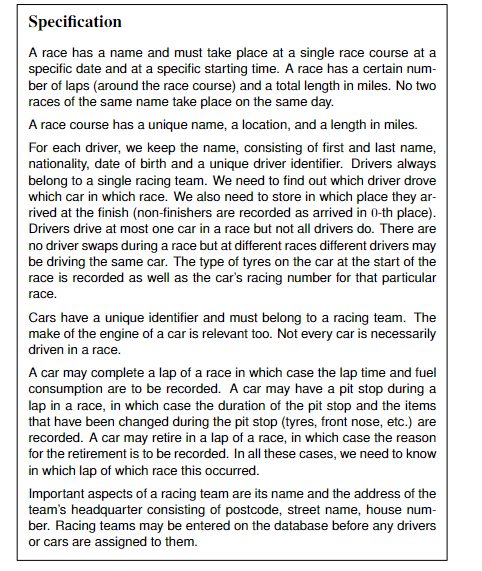vide an Entity-Relationship Model for a motor sport fan, based on the description in Table 1 on the next page. Present the model in the form of an Entity-Relationship diagram in Chen notation. Make sure to identify special attributes (including keys) in the diagram and include participation and cardinality con- straint annotations for your relationships.
vide an Entity-Relationship Model for a motor sport fan, based on the description in Table 1 on the next page. Present the model in the form of an Entity-Relationship diagram in Chen notation. Make sure to identify special attributes (including keys) in the diagram and include participation and cardinality con- straint annotations for your relationships.
Database System Concepts
7th Edition
ISBN:9780078022159
Author:Abraham Silberschatz Professor, Henry F. Korth, S. Sudarshan
Publisher:Abraham Silberschatz Professor, Henry F. Korth, S. Sudarshan
Chapter1: Introduction
Section: Chapter Questions
Problem 1PE
Related questions
Question
100%
Provide an Entity-Relationship Model for a motor sport fan, based on
the description in Table 1 on the next page.
Present the model in the form of an Entity-Relationship diagram in
Chen notation. Make sure to identify special attributes (including
keys) in the diagram and include participation and cardinality con-
straint annotations for your relationships.

Transcribed Image Text:Specification
A race has a name and must take place at a single race course at a
specific date and at a specific starting time. A race has a certain num-
ber of laps (around the race course) and a total length in miles. No two
races of the same name take place on the same day.
A race course has a unique name, a location, and a length in miles.
For each driver, we keep the name, consisting of first and last name,
nationality, date of birth and a unique driver identifier. Drivers always
belong to a single racing team. We need to find out which driver drove
which car in which race. We also need to store in which place they ar-
rived at the finish (non-finishers are recorded as arrived in 0-th place).
Drivers drive at most one car in a race but not all drivers do. There are
no driver swaps during a race but at different races different drivers may
be driving the same car. The type of tyres on the car at the start of the
race is recorded as well as the car's racing number for that particular
race.
Cars have a unique identifier and must belong to a racing team. The
make of the engine of a car is relevant too. Not every car is necessarily
driven in a race.
A car may complete a lap of a race in which case the lap time and fuel
consumption are to be recorded. A car may have a pit stop during a
lap in a race, in which case the duration of the pit stop and the items
that have been changed during the pit stop (tyres, front nose, etc.) are
recorded. A car may retire in a lap of a race, in which case the reason
for the retirement is to be recorded. In all these cases, we need to know
in which lap of which race this occurred.
Important aspects of a racing team are its name and the address of the
team's headquarter consisting of postcode, street name, house num-
ber. Racing teams may be entered on the database before any drivers
or cars are assigned to them.
Expert Solution
This question has been solved!
Explore an expertly crafted, step-by-step solution for a thorough understanding of key concepts.
Step by step
Solved in 2 steps with 1 images

Knowledge Booster
Learn more about
Need a deep-dive on the concept behind this application? Look no further. Learn more about this topic, computer-science and related others by exploring similar questions and additional content below.Recommended textbooks for you

Database System Concepts
Computer Science
ISBN:
9780078022159
Author:
Abraham Silberschatz Professor, Henry F. Korth, S. Sudarshan
Publisher:
McGraw-Hill Education

Starting Out with Python (4th Edition)
Computer Science
ISBN:
9780134444321
Author:
Tony Gaddis
Publisher:
PEARSON

Digital Fundamentals (11th Edition)
Computer Science
ISBN:
9780132737968
Author:
Thomas L. Floyd
Publisher:
PEARSON

Database System Concepts
Computer Science
ISBN:
9780078022159
Author:
Abraham Silberschatz Professor, Henry F. Korth, S. Sudarshan
Publisher:
McGraw-Hill Education

Starting Out with Python (4th Edition)
Computer Science
ISBN:
9780134444321
Author:
Tony Gaddis
Publisher:
PEARSON

Digital Fundamentals (11th Edition)
Computer Science
ISBN:
9780132737968
Author:
Thomas L. Floyd
Publisher:
PEARSON

C How to Program (8th Edition)
Computer Science
ISBN:
9780133976892
Author:
Paul J. Deitel, Harvey Deitel
Publisher:
PEARSON

Database Systems: Design, Implementation, & Manag…
Computer Science
ISBN:
9781337627900
Author:
Carlos Coronel, Steven Morris
Publisher:
Cengage Learning

Programmable Logic Controllers
Computer Science
ISBN:
9780073373843
Author:
Frank D. Petruzella
Publisher:
McGraw-Hill Education